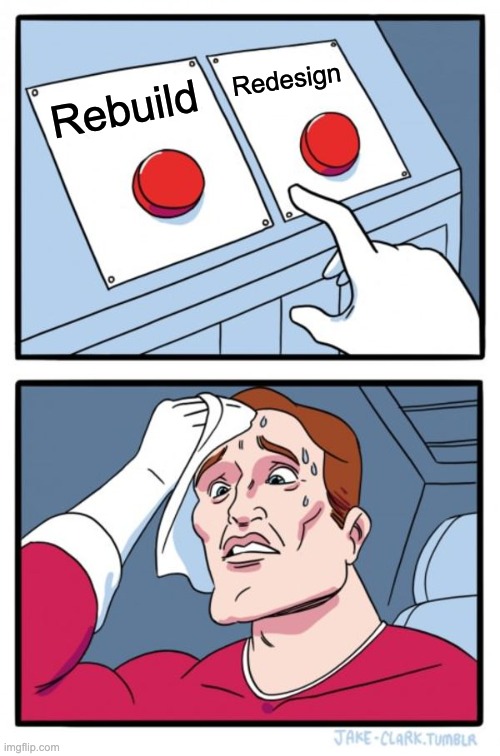Every website owner asks themselves at some point: “how long will my website last”? A while back, you invested time and resources into your website, and it’s served you well – but, how do you know if it’s still boosting your business or holding you back? The honest answer is that even the best built websites don’t stay effective forever, and the trick to keeping your business’ online momentum is knowing when to take a beat and revamp your site. Let’s help you determine when it’s right to redesign your website.
Every 2 to 3 years is a good time to redesign your website
After that, it’s a good time to start looking at a redesign, for plenty of reasons. It’s not a fixed timeline of any sort, but it’s a general rule of thumb. Perhaps most importantly, it’s also the cadence your competitors are likely redesigning their websites on.
Let’s dive into why this is the case.
Outdated designs lose customers
This is the most obvious reason. Modern, aesthetically pleasing design enhances brand perception and increases user engagement. The thing is, 2 – 3 years ago your website had a cutting edge design, but now? Even a few years can make a site feel behind the times.
Moreover, businesses simply evolve. You website, as the face of your business, needs to accurate reflect your modern brand (not your old brand) – and it needs to do it in a way that connects with modern visitors.
Technology hates the past
Everything on the internet moves so quickly. New devices are invented, browsers cease to exist (RIP Internet Explorer), screens change sizes, Google change’s their algorithms. We could go on, but you get it: if your website isn’t conforming to modern standards, it is actively dragging down your business’ potential. It sounds cliche – maybe even annoying, but it’s a measured fact.
As a simple example, between December 2013 and December 2015 (only 2 years), smartphone internet consumption grew by 78%. Technology evolves leaps and bounds, just like his, all the time. Websites that keep up reap the benefits. Those that don’t, simply don’t.

SEO, SEO, SEO.
Similar to the reality of evolving technology, search engines continue to change their standards. Your job, as a website owner, is to keep up. If your website is not performing well in search engine rankings despite your best SEO efforts, a redesign focusing on SEO optimization might be in order.
Your competitors are evolving

This one is (in our opinion) underrated. As Orbit Media puts it – “age is relative … to your competitors”. As your potential customers browse multiple sites in their process of shopping, they are constantly comparing their experiences on each site. Often times, their willingness to purchase comes down to how much they trust one site versus another. If your site isn’t up to snuff, the next site may very well get the sale.
Don’t just take our word for it
It’s not just us, it’s the general industry consensus (in fact, many think the lifespan might be shorter). Since we like data, here’s a roundup of other industry professionals and their opinions:
- Forbes suggests that businesses should consider a redesign every 2-3 years. This is due to the rapid evolution of web technology and design trends. However, Forbes also emphasizes that updates and improvements should be made continuously, not just at the point of a complete redesign.
- HubSpot recommends evaluating the website annually and considering a redesign if the site isn’t achieving its goals, if it’s not mobile-friendly, if it’s not optimized for search engines, or if the business’s branding has evolved.
- Smashing Magazine argues that a website should be redesigned when it is no longer effective. This could be because the site is not responsive or mobile-friendly, the bounce rate is high, or the site does not reflect the company’s current brand image. They suggest this could be as frequent as every 12 months.
- Neil Patel, a well-known digital marketing expert, suggests that while a website might need a redesign every 2-3 years, it is more important to make consistent tweaks and improvements based on user feedback and data analysis. He argues that continuous improvement can often be more effective than a complete overhaul.
- Design Squid emphasizes on the importance of adopting a growth-driven design approach. This strategy involves updating your website every 2-3 years to keep up with trends.
- Business Builders suggests regular redesigns, as often as 2-3 years, are essential for staying competitive and understanding the optimal frequency so your business can make sure its website best reflects its values and objectives.
- Search Engine Journal recommends updating your website’s copy, at the very least, every 2-3 years to adapt to search engine trends.
How strict is this timing?
Yes, you really shouldn’t leave your site stagnant beyond a few years, but that is not to say your website will crash and burn if you do. Businesses can’t always allocate the time and resources required to redesign their websites at a pace like that – and it’s okay. But, if you can’t swing it, even a lightweight refresh could go a long way.
Have your developer (hey, by the way, we are developers) write a list of all the things they would do to modernize your site, complete with estimates of how long it would take to complete each, and work with them to prioritize the items that would bring you the most benefit.
The takeaway
When your site was built, it was awesome – and hey, it’s probably still great. But every website needs a makeover from time to time to keep it operating at its full potential. Whether it’s to refresh the aesthetics, keep up with technology, or simply keep up with your competitors, a redesign every 2-3 years is a common and healthy thing.




